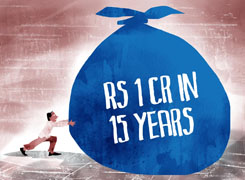Dear Sir, I am 42 years old, a govt employee having net salary 60k and my wife 36 ,is also a govt employee having net salary 42k. I have two daughters aged 9 and 5. I would like to get 1 crore at my 55. I have a loan EMI for 30k . I have been investing 10k SIP in MF for the past 6 months, PPF 5K since 2013, GPF 7K since 2015, stocks 1 lac for 10 years long-term, Sukanya 1K .Is it possible to get 1 crore or I should invest more for my children's education. Please suggest.
Ans: Evaluating Your Current Financial Position
Your financial commitment and disciplined savings are commendable. Balancing a government job, family responsibilities, and consistent investments indicates strong financial awareness. With a combined net salary of Rs 1,02,000 and an EMI of Rs 30,000, your investment capacity is substantial.
You have structured your investments across various avenues such as mutual funds, PPF, GPF, stocks, and Sukanya Samriddhi Yojana. This diversification is wise and shows strategic planning for long-term growth and your daughters’ future.
Analyzing Existing Investments
Mutual Funds
You've been investing Rs 10,000 monthly in mutual funds for six months. While this is a strong start, the duration is short to assess performance. However, continuing and potentially increasing this SIP can significantly contribute to your Rs 1 crore goal.
Public Provident Fund (PPF)
Investing Rs 5,000 monthly in PPF since 2013 is beneficial. PPF offers tax-free returns and a stable interest rate, which is good for safe, long-term savings. However, PPF alone may not suffice for aggressive wealth creation due to its moderate returns.
General Provident Fund (GPF)
GPF contributions of Rs 7,000 monthly since 2015 are solid. GPF provides a secure, long-term savings option for government employees. The returns are decent but not as high as equity-based investments, making it suitable for stability rather than high growth.
Stocks
Investing Rs 1 lakh in stocks for a 10-year horizon is a good strategy. Stocks can provide significant returns if chosen wisely and held long-term. Ensure these stocks are from reliable companies with strong fundamentals to mitigate risks.
Sukanya Samriddhi Yojana (SSY)
Investing Rs 1,000 monthly in SSY for your daughters is prudent. This scheme offers attractive interest rates and tax benefits, specifically aimed at securing your daughters' future education and marriage expenses.
Projecting Future Financial Goals
Reaching the Rs 1 Crore Target
To accumulate Rs 1 crore by age 55 (13 years from now), you need a strategic approach. Your current investments are a strong foundation, but additional steps are necessary. Here's a breakdown:
Step-Up SIP: Increase your mutual fund SIP annually by a certain percentage. This leverages incremental income and the power of compounding, significantly boosting your corpus over time.
Enhanced Diversification: While you have diversified, focusing more on equity mutual funds can yield higher returns. Actively managed funds, guided by a Certified Financial Planner (CFP), can outperform and mitigate risks better than passive funds like index funds.
Regular Review and Adjustments: Periodically review your investment portfolio with your CFP. Adjustments based on market conditions, financial goals, and risk tolerance can optimize returns.
Planning for Children's Education
Education costs are rising, and planning early is crucial. Your current savings and investments, like SSY and GPF, provide a good base, but additional steps can ensure sufficient funds for higher education expenses.
Education Fund: Create a dedicated education fund. Use a mix of equity and debt funds to balance growth and stability. Equity funds provide higher returns, while debt funds offer safety and liquidity.
Increasing Contributions: Gradually increase your contributions to this fund. As your income grows, allocate a higher percentage to this goal.
Using Child Plans: Consider child-specific mutual fund plans that offer benefits tailored to education needs. These plans often have features like automatic asset allocation based on the child's age, aligning investment risk with the time horizon.
Managing Loans and Debts
Your current loan EMI of Rs 30,000 is a significant commitment. Managing this effectively while investing for the future is critical.
Debt Repayment Strategy: Prioritize repaying high-interest loans first. Reducing your debt burden increases your capacity to invest more towards your financial goals.
Avoid New Debts: Limit taking on new loans unless absolutely necessary. Focus on maintaining a healthy debt-to-income ratio.
Enhancing Your Investment Strategy
Importance of Regular Investments
Consistent investing through SIPs is crucial. It inculcates financial discipline and takes advantage of rupee cost averaging, reducing the impact of market volatility.
Benefits of Actively Managed Funds
Actively managed funds, guided by professional fund managers, aim to outperform the market. They adjust portfolios based on market conditions, offering potential for higher returns compared to index funds.
Disadvantages of Direct Funds
Direct funds may have lower expense ratios but lack professional guidance. Investing through a CFP ensures you receive expert advice tailored to your financial goals, maximizing returns and minimizing risks.
Insurance and Risk Management
Separating Insurance and Investment
If you hold LIC, ULIPs, or investment cum insurance policies, consider surrendering them. These often provide suboptimal returns due to high charges and mixing insurance with investment. Reinvesting the proceeds into mutual funds can optimize growth.
Adequate Life and Health Insurance
Ensure you have sufficient life and health insurance. This protects your family from unforeseen events and secures your financial plans. Term insurance is cost-effective and provides substantial coverage.
Leveraging Tax Benefits
Tax planning is essential to maximize your net returns. Utilize tax-saving instruments effectively:
Section 80C Deductions: Investments like PPF, SSY, and ELSS qualify for tax deductions. Plan your investments to optimize tax benefits.
Long-Term Capital Gains (LTCG): Equity investments held for over a year qualify for LTCG, which are taxed favorably compared to short-term gains.
Regular Portfolio Review
Periodic portfolio review with your CFP ensures your investments align with your goals. Adjustments based on market performance, economic conditions, and personal circumstances optimize returns.
Annual Reviews: Conduct detailed reviews annually. Assess performance, rebalance asset allocation, and make necessary changes.
Rebalancing: Rebalance your portfolio periodically to maintain the desired risk-return profile. This involves selling overperforming assets and buying underperforming ones.
Understanding Market Cycles
Equity markets are cyclical, with phases of growth and correction. Understanding these cycles helps set realistic expectations and reduces panic during downturns.
Staying Invested: Stay invested during market downturns. Long-term investors benefit from the market's overall upward trajectory.
Avoiding Market Timing: Trying to time the market often leads to missed opportunities. Consistent investing, regardless of market conditions, yields better results.
Importance of Starting Early
Starting early maximizes the benefits of compounding. Your existing investments in PPF, GPF, and stocks are wise, but increasing your SIP contributions can accelerate growth.
Compound Interest: Compounding works best over time. Even small, consistent contributions grow significantly.
Incremental Increases: Gradually increase your SIP contributions as your income grows, leveraging compounding effectively.
The Emotional Aspect of Investing
Investing involves emotions. Market volatility can cause anxiety. A well-defined plan and professional guidance help stay focused on long-term goals.
Avoiding Impulsive Decisions: Stick to your investment plan. Avoid making changes based on short-term market movements.
Professional Guidance: Rely on your CFP for advice. They provide an objective perspective, reducing emotional biases.
Utilizing Financial Tools and Resources
Leverage financial tools to track and manage investments. Use SIP calculators, portfolio trackers, and financial planning software to stay organized.
SIP Calculators: Estimate future returns and plan contributions effectively.
Portfolio Trackers: Monitor investment performance, rebalance when necessary, and stay aligned with your goals.
Adapting to Life Changes
Financial goals and capacities change with life events like marriage, childbirth, or career shifts. Adapt your investment strategy accordingly.
Adjusting Contributions: Increase contributions during income growth phases. Reduce them if expenses rise temporarily.
Reevaluating Goals: Periodically reassess financial goals. Make adjustments based on evolving needs and circumstances.
Final Insights
Achieving Rs 1 crore by 55 years is possible with a strategic approach. Your existing investments form a strong base. Enhancing your SIP contributions, leveraging actively managed funds, and separating insurance from investment will optimize growth. Regular reviews, understanding market cycles, and adapting to life changes ensure alignment with your goals. With discipline, patience, and professional guidance, you can secure a prosperous future for your family.
Best Regards,
K. Ramalingam, MBA, CFP,
Chief Financial Planner,
www.holisticinvestment.in



























